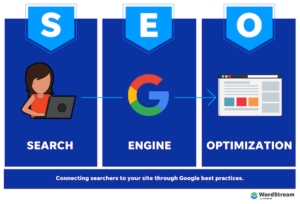SEO is a vital digital marketing tool that helps to drive traffic and achieve key business goals. It also builds trust, a key factor in search engine rankings.

It’s important to stay up-to-date on the latest SEO best practices, research and trends. Keeping up with these changes can help you improve your content and reach more people. Consult with SEO For Louisiana Small Businesses for expert guidance.
Keywords are the words or phrases that search engines use to find your content on the web. They’re also the terms that your customers type into search engines to discover you. When done right, keywords can help you reach your target audience and improve your SEO. However, keywords can be a little tricky to get the hang of. There are a lot of different factors that come into play, including search volume, difficulty, and organic CTR. You’ll also want to consider the relevancy and intent of each keyword and ensure that your content is addressing their needs.
There are four common types of search intent: informational, navigational, commercial, and transactional. Each has a unique purpose and requires a different approach to your content. To capture the most relevant traffic, you should focus on keywords that reflect the search intent of your audience and align with the goals of your business.
A good keyword has a high search volume and low level of difficulty, and it’s important to know how to balance these factors. You should also take into account the type of audience that’s searching for these terms and how you can appeal to them.
The best place to start is by identifying the keywords your customers are typing into search engines, which you can do with tools such as Google AdWords. Once you’ve identified your target keywords, you can use them in the title tag of your website and in the meta tags of individual pages. You can also include them in your site’s internal links and header tags.
You should also try to incorporate your keywords into your content in a natural way. Avoid forcing them into your text or adding too many of them. Keyword stuffing can make it difficult for search engines to understand your content and may result in a penalty. In addition, excessive repetition of keywords is distracting for users and can be a violation of Google’s spam policies. Aim for a ratio of about 1% to 2% of your keyword per page or post. In addition, don’t forget to include your keywords in the title and in one or more of the main subheadings (H2 and H3).
On-page optimization
If you’re serious about improving your search engine rankings, you must optimize the content and structure of your website. This is the foundation of SEO and is the best way to create a site that will endure algorithm changes. On-page optimization includes a number of different factors, from page URLs and content to HTML tags and website architecture. Some of these are more important than others, but you must keep them all in mind if you want to succeed.
The first step in on-page optimization is to identify keywords that are relevant to your business. These keywords will guide your search engine strategy and help you rank for more relevant queries. However, it’s important to remember that you shouldn’t overdo your keyword usage; otherwise, search engines will penalize you.
Title tags are another on-page SEO factor that is crucial for a successful website. They tell search engines what the page is about and are displayed in SERPs. It’s best to use title tags that include the target keyword at the beginning to ensure that it’s shown in searches. Title tags should be unique for each page, as it helps search engines index and understand the pages on your site better.
In addition to titles, meta descriptions are an important on-page SEO factor. They are the short, descriptive text that appears below a webpage’s title in a search engine results page. These are used to determine a page’s relevance and increase click-through rates. The meta description should be between 150 and 160 characters, and should contain the targeted keyword.
Another on-page SEO factor that is important for a successful website is internal linking. This involves connecting related pages on your website using keywords. It’s important to link to high-quality, authoritative websites when possible, and to use the right anchor text (the text that is clicked on) in your links. The correct use of anchor text can improve your on-page SEO and help you build trust with your audience. It can also improve the user experience and decrease your bounce rate. You should also make sure that all of your internal links are relevant and lead to valuable content.
Off-page optimization
Off-page optimization is a critical component of SEO, because it helps search engines understand your domain’s authority. It also supports on-page SEO efforts by adding credibility, relevance, and trustworthiness to your content. Off-page techniques include link building, social media promotion, and local business listings. These methods boost your website’s performance and encourage visitors to share it with others.
Regardless of how great your on-page content is, it won’t rank high on Google search results pages if it doesn’t have enough authority. The best way to improve your website’s authority is through off-page SEO strategies like link building, content marketing, and social bookmarking. Link-building is a crucial part of off-page optimization because it involves generating links from authoritative websites that are relevant to your niche. The quality of these links determines the overall authority of your domain. In addition to improving your SEO, off-page optimization will help you meet the E-E-A-T guidelines of Google’s Quality Rater Guidelines.
When a reputable and relevant site or person links to your content, it’s a vote for your content. It tells search engines and the public that your content is valuable and deserves to be surfaced in search results.
A strong off-page optimization strategy will increase your website’s brand awareness, reputation, and credibility. It will also improve your ranking on search engine result pages (SERPs) and drive more traffic to your website. Creating a robust off-page strategy will require a significant amount of time and effort, but it will help you attract more visitors and convert them into customers.
To start, you should create a list of industry-specific directories and business listings. Make sure that your listing information is up-to-date, accurate, and consistent. Additionally, you should promote your website and brand by participating in relevant conferences and events. Finally, you should monitor online reviews and ratings from satisfied customers.
The key to successful off-page optimization is consistency. It takes time to build a solid digital footprint, but it’s important to maintain consistency across all platforms. If you fail to do so, your rankings will suffer and you may even be penalized by Google.
Link building
Link building is the process of acquiring hyperlinks (usually called “backlinks”) from other websites to your own website. This is one of the most important aspects of SEO and it can have a significant impact on your search engine rankings. However, it’s not something that you can do once and forget about – it’s an ongoing process that requires a lot of time and energy.
The best way to do it is by creating high-quality resources that other websites will want to link to. This can be in the form of a blog post, tool, research study, or infographic. This can be done on your own or with the help of a third-party developer. After you create a valuable resource, it’s essential to promote it through social media and email outreach. This will ensure that as many people as possible see it and are able to use it.
Another way to build links is by reaching out to bloggers and journalists in your niche. This is often referred to as “outreach” in the SEO world. Often, the goal of this type of outreach is to get backlinks, but there are other benefits as well. For example, it can establish you as a thought leader in your industry, which can lead to more traffic and sales. It can also lead to long-term relationships with influencers and journalists, which can have a positive impact on your business.
Once you have a list of potential backlinks, you can start to reach out to them. Try to avoid using spammy tactics, such as trying to shoehorn keywords into the anchor text of the links you’re requesting. This can cause Google to suspect you’re gaming the system, which could lead to a penalty.
Other good methods for getting backlinks include participating in forums, communities, and Q&A websites. You can also perform active link-building by using tools to find broken links on other pages and recommending your own content as a replacement. This is known as “broken link building.” It’s an effective way to increase your search engine visibility without paying for links.
